Introduction
Business cycles have long captured the interest of economists, and these transient fluctuations typically garner a great deal of attention from the media and policymakers as well. But over the last 15 years, many economists have turned their attention away from short-term cycles and focused instead on long-term growth trends. This new focus has been driven, in part, by the observation that even small differences in long-term growth rates lead to huge differences in standards of living over time, disparities that far exceed the impact of transitory cyclical change.
For example, Nobel Laureate Robert Lucas, a University of Chicago economist, has pointed out that while South Korea and the Philippines had similar per capita incomes in 1960, the superior growth of South Korea over the following 28 years (6.2 percent per year vs. 1.8 percent) resulted in Korean incomes being three times larger than the incomes in the Philippines by 1988. While this example is especially striking, a general observation from the growth literature is that differences in long-term growth rates have a much larger impact on the level of income over time than do typical business cycle fluctuations.
Current research on economic growth and on business cycle fluctuations most often focuses on nations, but this article employs tools from both research fields to examine the performance of a state economy, Minnesota's. And by following Minnesota's progress over the past 70 years, it draws insights that may prove valuable to economists and policymakers in other states, as well.
The study of state business cycles is hardly new. In fact, more than 20 years ago, Federal Reserve Bank of Minneapolis economists Robert Litterman and Richard Todd studied Minnesota business cycles in a Quarterly Review article titled, "As the Nation's Economy Goes, So Goes Minnesota's".
The current article begins by updating Litterman and Todd's analysis, and while additional facts are uncovered, their basic conclusion still holds true: The state economy fluctuates closely with the national economy.
Careful studies of long-term growth in individual states are less common, but the economic implications are arguably more important. After the analysis of Minnesota business cycles, this article therefore turns to an analysis of the state's long-term growth. The discussion here centers on an important, but underappreciated, fact about the Minnesota economy: Over the past 70 years, Minnesota's per capita income has slightly, but steadily, outgrown U.S. per capita income.
To understand why this fact is so important, consider the following. Minnesota per capita income in 1929 was 14 percent below the national figure. By 2001, state per capita income had risen to 8 percent above U.S. per capita income. Had Minnesota's economy grown at the same pace as the nation's economy over the past 70 years, its current per capita income would be 21 percent lower than it is today. So while the recent recession has been traumatic for Minnesotans who have lost their jobs, the 1 percent decrease in real per capita income statewide from the start of the recession in the first quarter of 2001 to the fourth quarter of 2001 is small in comparison with those long-run gains enjoyed by Minnesota's population—both in absolute terms and relative to the national average—between 1929 and 2001. The second part of this article examines this long-term increase in Minnesota's relative income and helps illuminate the sources of that increase. But first, the state business cycle is examined.
Defining business cycles
To compare Minnesota business cycles with national business cycles, as well as business cycles in other states, a measure of economic activity and a clear definition of business cycles are needed. The measure of economic activity used here is real earned income, which includes all wage and salary earnings, plus proprietor's income. This is a broad measure of activity that encompasses all sectors of the economy. The data have been adjusted for inflation, and all variables are measured in 1996 dollars.
Following modern business cycle theory, business cycles are defined as the fluctuations in earned income around the long-run trend. Figure 1 illustrates the basic idea of this definition for the U.S. economy. The top panel shows U.S. earned income and a smooth trend line drawn through the data. The percent deviations between the actual data and the trend line are shown in the bottom panel, and are defined to be the business cycle. The same procedure is used to define the business cycle for each state economy.
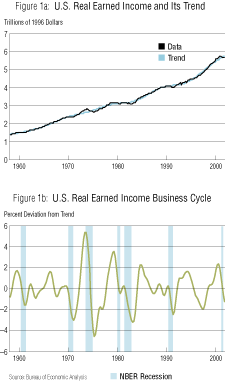
Source: Bureau of Economic Analysis
This definition of business cycles has several appealing features. The business cycles for each state and for the nation are measured independently of each other; states do not always suffer downturns with the national cycle. Business cycles are measured in percentage terms, which allows for a more meaningful comparison of cycles between big and small states, and between individual states and the nation. And finally, the volatility and timing of business cycles can be easily compared.
There is a visible relationship between this measure of the national business cycle and the more widely known business cycle dating of peaks and troughs announced by the National Bureau of Economic Research. NBER recessions are indicated in the bottom panel of Figure 1 by shaded areas. Generally speaking, NBER recessions correspond to intervals in which the business cycle line falls from above trend to below trend. However, some periods of decline in the business cycle line are not associated with NBER recessions, such as the decline during the mid-1990s.
Comparing business cycles: some bad news
The Minnesota and U.S. business cycles show a striking similarity (Figure 2), somewhat surprising given that the Minnesota economy constitutes less than 2 percent of the national economy. Clearly, the Minnesota cycle has closely tracked the national cycle over the 20 years since the Litterman-Todd analysis. The Minnesota cycle is somewhat more volatile than the national cycle, though the excess volatility appears to have lessened in recent years.
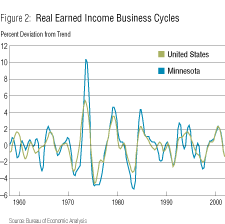
Source: Bureau of Economic Analysis
The fact that the Minnesota economy fluctuates so closely with the U.S. economy is not unusual. It is true for most states, despite large differences in their economies. In 40 of the 50 states, over half the variability in each state economy is directly associated with fluctuations in the national economy.
Compared with other state economies over this period, the Minnesota business cycle is more volatile; indeed, it ranks as the 14th most volatile state. While this may seem disturbing for Minnesota, it is only part of the story and is, in fact, rather misleading.
Composition and stability: bad news turns better
Why is the Minnesota economy so volatile, and is it becoming more or less so? To answer these questions, it is useful to look at the individual sectors of the state economy more closely because different sectors of the economy fluctuate very differently. For example, the farm, manufacturing and construction sectors tend to be relatively volatile, while the services and government sectors are relatively stable. The overall volatility of a state economy can therefore be strongly influenced by the relative size of its various sectors.
Litterman and Todd reported 20 years ago that the sectoral composition of Minnesota's economy was quite similar to the nation's. That continues to hold true, as the compositions of the two economies have evolved quite similarly over time.
But a prominent distinction between Minnesota and the nation historically has been the relatively large size of Minnesota's farm sector. Today, however, this difference has disappeared. Since 1960, the farm share has fallen from roughly 5 percent to 1 percent in the U.S. economy, and from almost 10 percent to 1 percent in the Minnesota economy.
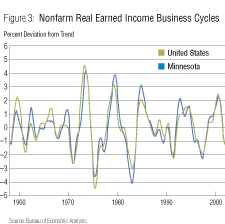
Source: Bureau of Economic Analysis
What makes the decline in Minnesota's farm share especially noteworthy is that farm sector earnings are extremely volatile, and that volatility largely accounts for the relatively high volatility in the state economy described earlier. Figure 3 illustrates the nonfarm business cycles in Minnesota and the United States. With farm earnings excluded, Minnesota's business cycle has had the same volatility as the U.S. cycle and less volatility than most state business cycles, ranking as the 37th most volatile state rather than the 14th.
Furthermore, the declining farm sector share also helps explain the declining excess volatility of Minnesota's business cycle. Since Minnesota's farm sector is likely to remain small, Minnesota's future volatility will be determined primarily by its nonfarm economy—good news in light of its relative stability over the past 40 years.
A primary strength of Minnesota's nonfarm economy is its diversity. This diversity contributes to its stability. It is interesting to note that most individual sectors of the state's economy are more volatile than the nonfarm economy as a whole, but the sectors' fluctuations do not all coincide. By blending a wide range of economic activities, the Minnesota economy is more stable, in much the same way that a well-diversified stock portfolio reduces risk.
Also, as with a stock portfolio, there is something of a trade-off between risk and reward for a state economy. Several relatively volatile sectors, such as the manufacturing, and finance, insurance and real estate sectors, have relatively high average wages, while low-volatility sectors such as the services and government sectors have low average wages. So another benefit of Minnesota's diverse economy is that it can reap some of the reward in high wages that relatively volatile sectors offer, without greatly decreasing its stability.
Long-run trends: even better news
While the study of business cycles remains of interest, many economists have turned more of their attention toward long-term economic growth. The reason lies in a simple, yet powerful insight: Small differences in growth rates that persist for long periods lead to large differences in the level of economic activity and standards of living, differences that dwarf the effect of minor, short-term deviations from the long-run trend.
Consider two neighboring hypothetical economies, A and B, that have the same per capita income today. Suppose economy A grows at an average annual rate of 4 percent, while economy B grows at 2 percent. Under this scenario, residents of economy A will have double the income of their poor neighbors after 35 years. The residents of economy B will have little sympathy if economy A then suffers a recession in which its residents' average income declines by a relatively trivial 2 percent, since economy A residents will still be 98 percent richer.
Since 1929, U.S. real per capita personal income has risen almost fivefold (Figure 4), and Minnesota income levels have increased similarly.* However, a closer inspection reveals that Minnesota income started below national income and finished above it. Since 1929, real U.S. per capita income has grown at an annual rate of 2.23 percent, while Minnesota per capita income rose 2.56 percent annually. Although this difference is small on an annual basis, the cumulative effect over 70 years is substantial. While U.S. income rose almost 500 percent over the entire period, Minnesota income grew more than 600 percent.
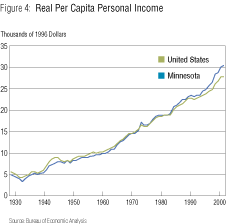
Source: Bureau of Economic Analysis
Another way to see the relative gain in Minnesota's income over time is to look at state per capita income as a percent of the U.S. average. Minnesota's income has steadily increased relative to average U.S. income for the last 70-plus years (Figure 5). The long-run trend is quite consistent, though there were large but temporary variations from the general trend during the Great Depression and during World War II and its aftermath. In 1929, Minnesota per capita income was 86 percent of the national average. It surpassed the U.S. figure in the early 1970s and continued to climb to 108 percent of U.S. income in 2001. Put in today's dollars, if Minnesota average income were still 86 percent of the U.S. average, state income would be almost $7,000 per person lower.
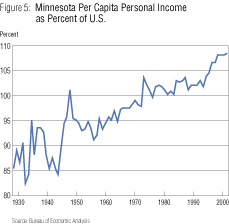
Source: Bureau of Economic Analysis
A closer look at trends
What accounts for Minnesota's superior growth over the past 70 years? A definitive answer is beyond the scope of this article, but looking a little more closely at the data provides some insights.
First, there is an important distinction between the growth in Minnesota income from 1929 through the late 1950s and the growth from the late 1950s to the present. In the earlier period, years in which Minnesota income was catching up to the national average, the growth was associated with a general convergence in state per capita income levels across the country. That is, poor states were generally growing more rapidly than rich states, so that the difference between per capita income in rich and poor states narrowed substantially.
Minnesota's ranking among states in terms of per capita income averaged around 25th from 1929 to 1959, with some small, short-lived variations. So while Minnesota's income rose notably as a percent of the U.S. average during this period, its relative position among states was unchanged. This does not explain Minnesota's relative growth during this period, but it does suggest that the state's growth was part of a nationwide phenomenon, and not something unique to Minnesota.
This situation changed after the 1950s. Minnesota's per capita income ranking began climbing during the 1960s, rising to 17th by the late 1970s, and reaching the top 10 during the latter half of the 1990s. In 2001, Minnesota stood eighth. Between 1959 and 2001, Minnesota's annual per capita income growth rate of 2.76 percent outpaced 38 of the 50 states, and only five states grew at rates above 2.90 percent.
Furthermore, Minnesota's per capita income growth since the late 1950s was not a regional phenomenon. Prior to the 1960s, Minnesota income grew at roughly the same pace as average per capita income in the Plains states (Iowa, Kansas, Minnesota, Missouri, Nebraska, North Dakota and South Dakota) and in the Great Lakes states (Illinois, Indiana, Michigan, Ohio and Wisconsin) (Figure 6). The Great Lakes states had higher average incomes, but similar growth. Starting in the 1960s, Minnesota income began to rise more quickly than the average in both regions.
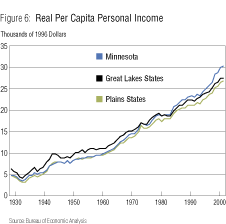
Source: Bureau of Economic Analysis
So Minnesota's per capita income growth over the past 40 years was unique, and thus more interesting. Analysis of the different components of personal income reveals that most of the state's relative gain was driven by an increase in per capita labor earnings, with income from capital holdings (dividends, interest income and rental income) contributing to a lesser extent. The third component, transfer payments (primarily comprising government payments for retirement and disability insurance benefits, medical payments and income maintenance benefits), had a detrimental effect on the state's relative income, as Minnesota's share of total transfer payments fell over this period.
Since labor earnings per capita is the primary source of Minnesota's relative growth, tracking down the source of this growth should be informative. First, note that an increase in labor earnings per capita can result from higher earnings per worker and/or more workers per capita. As it turns out, both factors have been influential in Minnesota.
Some of Minnesota's relative gain in per capita income was due to an increase in the fraction of Minnesotans employed. Minnesota currently has one of the highest employment-to-population ratios of any state in the country. Furthermore, the increase in the fraction of Minnesotans working has been substantial. The percent of all Minnesotans employed increased from about 41 percent in 1970 to 54 percent in 2000. But what is important for Minnesota's relative gain is that the fraction of Minnesotans employed rose faster than the national figure, which increased from roughly 39 percent to 48 percent over the same period.
A higher fraction of people working does not account for all of Minnesota's rise, however. Earnings per worker also increased relative to the national figure. But the increase in earnings does not necessarily reflect higher wages within individual sectors. For example, earnings per worker could have risen as workers left low-paying jobs in the farm sector and found higher-paying jobs in other sectors, such as manufacturing. However, nonfarm earnings per worker also rose during this period, suggesting that a shrinking farm sector is not the entire story.
Finally, economic theory identifies labor productivity growth, or growth in output per worker, as a fundamental driving force for long-term increases in labor earnings per worker. Productivity growth is also viewed as critical for sustained long-term growth, since the fraction of Minnesotans working cannot rise indefinitely. So an interesting question is whether the gain in labor earnings per worker was associated with a gain in the relative productivity of Minnesota's workforce.
A first look at the data indicates that Minnesota's labor productivity did increase faster than the nation's. Since 1977, the productivity of the Minnesota workforce relative to the U.S. average, as measured by gross state product per worker in both, increased noticeably during both the 1980s and 1990s. (Data prior to 1977 are not readily available for GSP.)
Rising education
The relative increase in labor productivity, labor earnings and employment per capita all suggest that there may have also been a rise in the relative human capital, or skills, of Minnesota residents. This section examines whether the human capital of Minnesota's residents increased faster over the past 50 years than did the nation's, on average, using education as a crude proxy for human capital.
Education levels have increased dramatically throughout the country over the past 50 years. If education is to play a role in the explanation for Minnesota's incomes rising faster than the nation's as a whole, it must be that education levels have risen more rapidly in Minnesota's population. There is some evidence that this is the case.
In 2000, Minnesota ranked seventh among the states in the percent of residents 25 years and over with at least a bachelor's degree (31.2 percent compared to 25.6 percent in the nation), and third in the percent of residents with a high school degree (90.8 percent vs. 84.1 percent for the nation).
Earlier in the century, however, the education level of Minnesota's population was not especially impressive relative to the country as a whole. For example, in 1950, the percent of Minnesotans aged 25 and over with four or more years of college was 5.6 percent, the same as the national figure. The fraction of the population with four or more years of high school was also much closer to the national average in 1950 (34.7 percent in Minnesota vs. 33.4 percent for the United States). Finally, the median duration of schooling in 1950 for Minnesotans was nine years, lower than the national figure of 9.3 years. Minnesota's reputation as having an educated populace apparently was being established during the same period that Minnesota's per capita income was beginning to surpass the national average.
Care should be taken in drawing inferences from this observation on education. A good educational system does not itself guarantee a highly educated population and strong economic growth. North Dakota has one of the highest high school graduation rates in the country, as well as one of the nation's highest percent of students continuing on to college. Yet the state ranks relatively low nationally in the percent of its adult population with a college degree, and the state's per capita income ranked 37th in 2001. Many of North Dakota's educated young people leave the state. Obviously, there is an important interplay between an education system that supplies educated people and a state economy with enough jobs that demand those educational skills. It is difficult to disentangle the effects of the labor market's two sides.
Conclusion
This article has examined the performance of the Minnesota economy using the tools and techniques commonly employed by economists studying national phenomena, such as the large disparity in income growth rates across countries. Sticking with this parallel, and with the Minnesota economy in mind, it seems natural to ask what the literature on economic growth has found regarding explanations for the differences in growth across countries.
Not surprisingly, identifying the specific causes behind the differences in growth rates across countries has proven difficult. But progress has been made. Differences in productivity across countries have been identified as a critical factor, and government policies can affect productivity significantly. Government subsidies to failing or inefficient firms, for example, may preserve jobs in the short-run, but delay the transition to more efficient production practices that enhance economic growth and long-term job creation. Tax policies have also been found to have a large impact on national incomes. Still other research concludes that the incentives to accumulate human capital are a crucial part of the explanation for cross-country income growth differences.
Which of these factors, or perhaps others, best explain the steady
increase in Minnesota's income per capita over the past 70 years is
an important question for state policymakers to address. Business
cycle fluctuations will almost surely continue to dominate the public's
attention, making it easy to overlook important long-run trends and
tempting policymakers to focus on cyclical, short-term economic forces
and policies. While it will continue to be important to mitigate the
hardship of recessions, the future prosperity of the Minnesota economy
depends upon understanding the long-term economic forces and policies
that have gotten us to where we are today.
* Personal income is a more comprehensive measure of income than the earned income data used in the previous section. In addition to income from labor services, it includes income derived from capital holdings (dividends, interest and rent) and transfer payments by governments and businesses. Only earned income data are available by sectors, and sectoral data provided key insights in the business cycle analysis.





